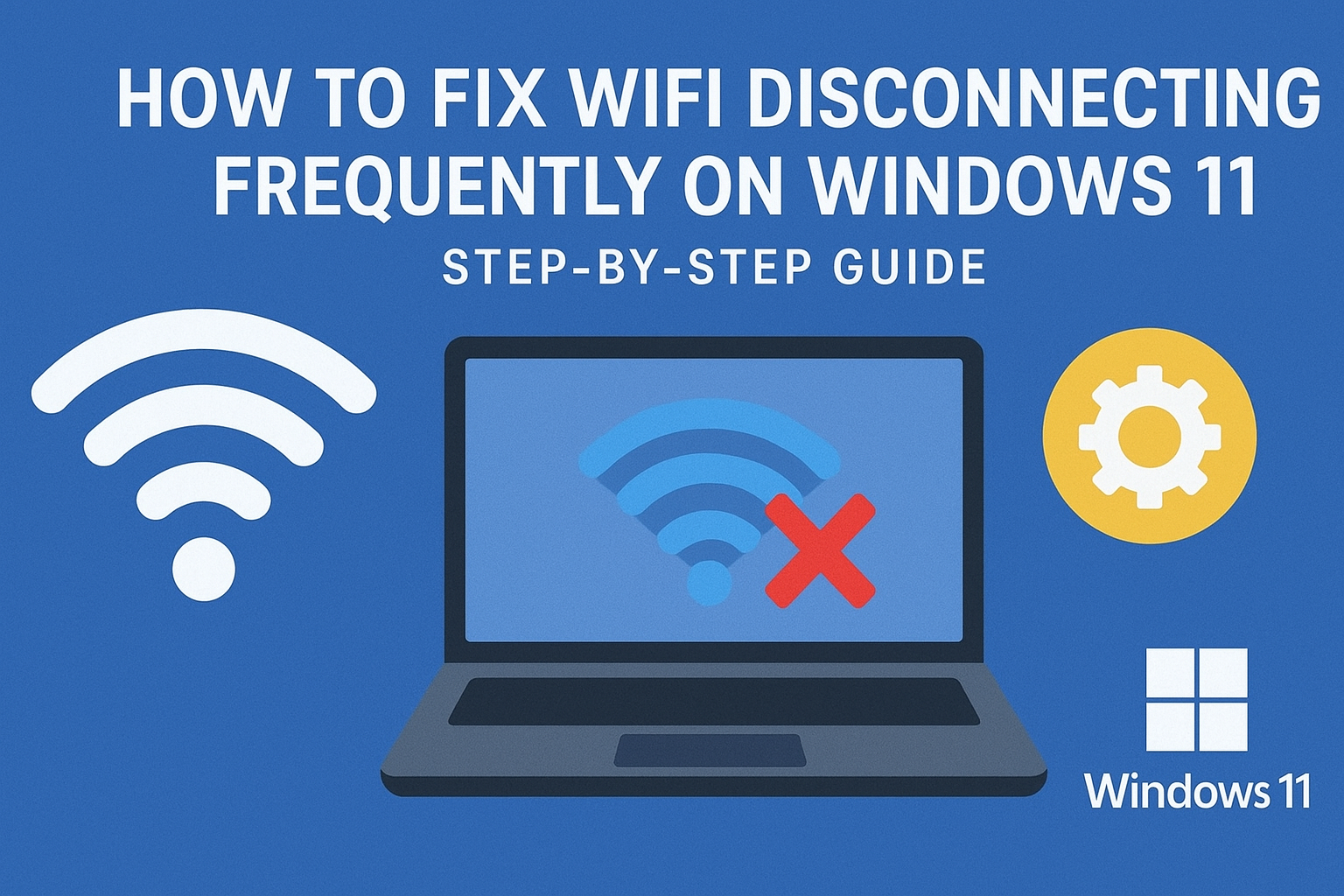How to Fix WiFi Disconnecting Frequently on Windows 11 (Step-by-Step Guide)

Few things are more frustrating than working on an important task, streaming your favorite show, or gaming online only to have your WiFi disconnecting frequently on Windows 11. This problem is common and can happen due to software glitches, outdated drivers, or even power-saving settings.
Why does it matter? Because a stable internet connection isn’t just a convenience—it’s a necessity. Whether you’re in online classes, remote work meetings, or casual browsing, frequent disconnections can disrupt productivity and cause frustration.
Don’t worry, though! In this guide, we’ll explore the common causes of WiFi issues and provide step-by-step fixes you can try to restore a reliable connection.
Common Causes of WiFi Disconnecting on Windows 11
Before jumping into fixes, let’s understand why this happens:
Outdated or corrupted network drivers
Power-saving settings turning off the WiFi adapter
Faulty router configuration
Windows 11 updates that disrupt network stability
Conflicting apps or VPNs interfering with the connection
Weak WiFi signals due to interference or distance
Incorrect network settings like DNS misconfiguration
Step-by-Step Guide to fix wifi disconnecting frequently on Windows 11
Let’s go through reliable solutions one by one. Try them in order, starting from the simplest.
1. Restart Your PC and Router
Sometimes the issue is temporary and can be fixed by restarting devices.
Turn off your router, wait for 30 seconds, then restart.
Restart your Windows 11 PC.
This refreshes network configurations and clears temporary glitches.
2. Forget and Reconnect to WiFi
If the connection keeps dropping, reconnecting might solve it:
Go to Settings → Network & Internet → Wi-Fi.
Click on Manage known networks.
Select your WiFi network → Forget.
Reconnect by entering your password again.
3. Update Network Drivers
Outdated or corrupted drivers are one of the main reasons behind WiFi disconnecting frequently Windows 11.
Steps to update:
Right-click Start Menu → Device Manager.
Expand Network Adapters.
Right-click your WiFi adapter → Update driver.
Select Search automatically for drivers.
If automatic updates don’t help, download the latest drivers from your laptop or motherboard manufacturer’s website.
4. Change Power Management Settings
Windows sometimes turns off WiFi adapters to save power.
Open Device Manager.
Right-click your WiFi adapter → Properties.
Go to Power Management tab.
Uncheck Allow the computer to turn off this device to save power.
5. Disable Random Hardware Features (802.11 Power Settings)
You can manually tweak advanced WiFi settings:
Go to Control Panel → Network and Sharing Center → Change adapter settings.
Right-click WiFi → Properties → Configure.
Go to the Advanced tab.
Look for options like Roaming Aggressiveness or Preferred Band and set them appropriately (e.g., Medium).
6. Reset Network Settings
If nothing else works, reset your network settings:
Open Settings → Network & Internet → Advanced network settings.
Scroll down and click Network reset.
Restart your PC.
Note: This will remove all saved WiFi networks, so you’ll need to reconnect manually.
7. Change DNS Settings
Sometimes DNS issues cause frequent disconnections. Switching to Google’s DNS often fixes it.
Open Settings → Network & Internet → Wi-Fi → Hardware properties.
Scroll down → Edit DNS settings.
Choose Manual → IPv4.
Set Preferred DNS:
8.8.8.8, Alternate DNS:8.8.4.4.8. Check Windows Updates
Microsoft frequently releases patches for known bugs.
Go to Settings → Windows Update.
Click Check for updates and install any available updates.
9. Disable VPN or Third-Party Apps
Some VPNs or security tools can conflict with WiFi. Try disabling them temporarily and check if the connection stabilizes.
10. Consider a USB WiFi Adapter (Alternative Fix)
If your built-in adapter is faulty, consider using an external USB WiFi adapter. They are inexpensive and often more stable than older laptop adapters.
| Fix Method | Difficulty | Effectiveness | When to Use |
|---|---|---|---|
| Restart PC/Router | Very Easy | Medium | First quick attempt |
| Forget & Reconnect | Easy | Medium | If WiFi disconnects occasionally |
| Update Drivers | Medium | High | If drivers are outdated |
| Power Settings Change | Medium | High | If WiFi drops on battery use |
| Reset Network | Medium | High | If nothing else works |
| Change DNS | Easy | Medium | If browsing issues occur |
| Use External Adapter | Easy | High | If internal adapter is faulty |
Practical Tips to Prevent WiFi Disconnecting Issues
Place your router in a central, elevated position for better signals.
Avoid using WiFi near interference sources (microwaves, cordless phones).
Keep your Windows 11 updated regularly.
Upgrade your router if it’s more than 4–5 years old.
Place router in a central location
Avoid interference from microwaves/cordless phones
Prefer 5GHz WiFi over 2.4GHz for speed/stability
Upgrade router if it’s 4–5 years old
Regularly update Windows 11 & drivers
When Nothing Works…
If you’ve tried all fixes and your Windows 11 WiFi keeps disconnecting, it may be a hardware issue. In that case:
Test another device with the same WiFi to confirm if the router is faulty.
Contact your Internet Service Provider (ISP).
Visit a service center to check your laptop’s WiFi adapter.
Outcome
Frequent WiFi disconnections can disrupt work, entertainment, and online communication. Luckily, with the fixes above—from updating drivers to adjusting power settings—you can solve most cases of WiFi disconnecting frequently on Windows 11.
Try the solutions step by step, and don’t forget the final note: keeping your system, drivers, and software updated is the best long-term practice to prevent such issues.
👉 If this guide helped you, share it with friends facing similar issues and check out our other tutorials on fixing Windows problems!

